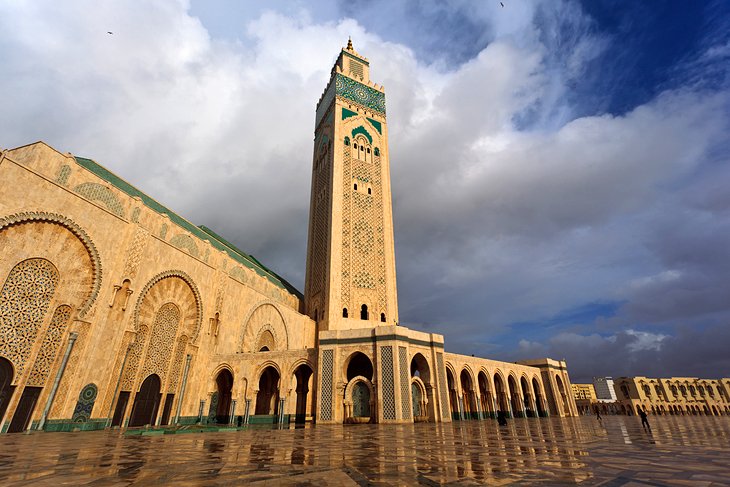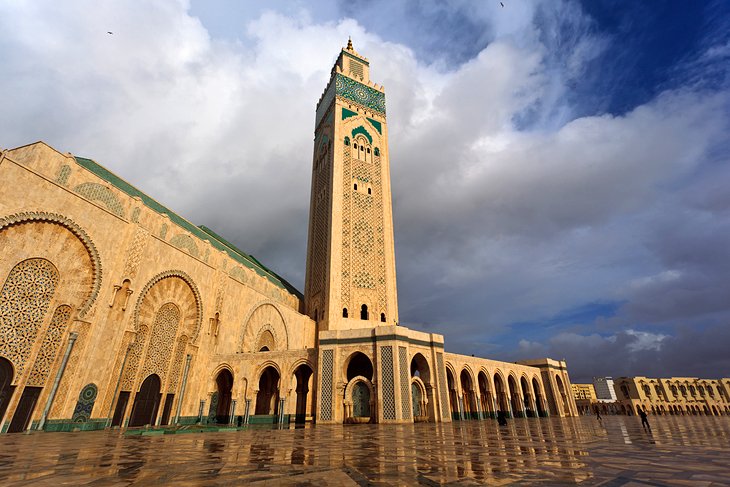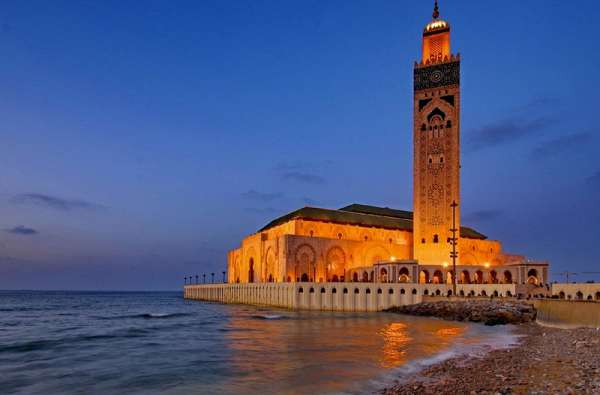
Morocco, a land where ancient traditions dance with vibrant modern life, where desert sands whisper tales of caravans, and where bustling medinas thrum with an intoxicating energy, beckons travelers with its irresistible charm. From the azure waters of the Atlantic to the majestic peaks of the Atlas Mountains and the endless expanse of the Sahara, Morocco offers a kaleidoscope of experiences that captivate the senses and nourish the soul. This comprehensive guide delves into the heart of this North African gem, exploring its most iconic attractions, its rich history, and providing practical advice to make your Moroccan adventure unforgettable.
Unveiling Morocco’s Crown Jewels: Top Attractions
Morocco is a treasure trove of diverse landscapes and captivating cities, each offering a unique glimpse into its multifaceted identity. Here are some of its most compelling attractions:

Related Articles about Morocco’s Enchanting Tapestry: A Journey Through its Top Attractions and Essential Travel Guide:
- Tokyo’s Crown Jewels: A Guide to Unforgettable Stays and Experiences in the Metropolis
- Rome: An Eternal City Awaits – Your Comprehensive Travel Guide
- Casablanca: A Symphony of Old and New in Morocco’s Vibrant Heart
- Osaka: A Culinary Capital and Cultural Kaleidoscope
- Busan Beckons: A Guide to Unforgettable Stays in South Korea’s Coastal Gem
1. Marrakech: The Ochre City’s Bewitching Embrace
Marrakech, arguably Morocco’s most famous destination, is a city that ignites the imagination. Its beating heart is the Jemaa el-Fnaa, a UNESCO World Heritage site and a spectacle of human activity. By day, it’s a vibrant marketplace with snake charmers, storytellers, and juice stalls. As dusk descends, it transforms into a colossal open-air restaurant, filled with the aroma of grilling meats and the sounds of Gnaoua musicians.
Beyond the square, the Medina of Marrakech is a labyrinth of narrow alleys, each turn revealing hidden riads, artisan workshops, and spice souks. Don’t miss the stunning Koutoubia Mosque, its minaret a beacon of the city, and the opulent Bahia Palace, a masterpiece of Moroccan architecture showcasing intricate tilework and serene courtyards. For a tranquil escape, the Majorelle Garden, once owned by Yves Saint Laurent, offers a splash of cobalt blue against a backdrop of exotic plants.
2. Fes: A Living Museum of Moroccan Heritage
Fes, the oldest imperial city, is a journey back in time. Its Medina of Fes el-Bali is the largest car-free urban area in the world, a sprawling maze where donkeys are the primary mode of transport. This UNESCO site is renowned for its meticulously preserved medieval architecture, including the University of Al Quaraouiyine, the oldest continuously operating university in the world, and the iconic Chouara Tannery, where leather is still dyed using traditional methods, creating a vibrant, albeit pungent, spectacle.
Wander through the Souk Semmarine for intricate metalwork and leather goods, and the Souk Nejjarine for exquisite woodwork. The Bou Inania Madrasa is a testament to Islamic art and architecture, with its stunning mosaics and carved cedarwood. Fes offers an authentic and immersive experience of traditional Moroccan life.
3. Chefchaouen: The Blue Pearl of the Rif Mountains
Nestled in the Rif Mountains, Chefchaouen is a dreamscape of cerulean hues. Its medina is a labyrinth of narrow, winding streets, where every building, door, and staircase is painted in a dazzling spectrum of blues. This picturesque town offers a serene escape from the hustle and bustle of larger cities.
Explore the charming Plaza Uta el-Hammam, the main square, and visit the Kasbah Museum for a glimpse into the region’s history. Hike to the Spanish Mosque for breathtaking panoramic views of the blue city and the surrounding mountains. Chefchaouen is a photographer’s paradise and a haven for those seeking tranquility.

4. Sahara Desert: The Majesty of the Dunes
An adventure to the Sahara Desert is an essential Moroccan experience. Embark on a camel trek into the vast, undulating dunes of Erg Chebbi or Erg Chigaga. Witness the mesmerizing spectacle of the sunset painting the sand in hues of gold and orange, followed by a night under a canopy of a million stars.
Spend a night in a traditional Berber desert camp, enjoying a delicious tagine and the hypnotic rhythms of local music. Wake up to the ethereal beauty of sunrise over the dunes, a truly unforgettable moment. The silence and immensity of the desert offer a profound sense of peace and wonder.
5. Essaouira: The Wind-Swept Coastal Gem
Essaouira, a charming coastal city, offers a refreshing contrast to the inland heat. Its fortified medina, a UNESCO World Heritage site, boasts whitewashed buildings with blue accents, a relaxed atmosphere, and a refreshing sea breeze. The Skala de la Ville, a rampart overlooking the Atlantic, offers stunning ocean views and is a popular spot for watching the sunset.
Essaouira is a haven for water sports enthusiasts, particularly kite surfing and windsurfing, thanks to its consistent winds. Explore the bustling fishing port, where colorful boats bob in the harbor and fresh seafood is readily available. The city’s artistic soul is evident in its numerous galleries and artisan workshops.
6. Atlas Mountains: Majestic Peaks and Berber Villages
The High Atlas Mountains offer a dramatic landscape of snow-capped peaks, verdant valleys, and traditional Berber villages. Hike through stunning trails, discover hidden waterfalls, and immerse yourself in the rich culture of the Berber people.
The Toubkal National Park is a popular destination for trekkers, with Mount Toubkal being the highest peak in North Africa. Explore charming villages like Imlil, a gateway to many hiking routes, and Ourika Valley, known for its saffron fields and cascading waterfalls. Visiting a local Berber family for mint tea is a heartwarming experience.
7. Casablanca: The Modern Metropolis with Historic Charm
Casablanca, Morocco’s economic powerhouse, is a vibrant metropolis that blends modern architecture with colonial influences and a touch of Art Deco elegance. The iconic Hassan II Mosque, one of the largest mosques in the world, is a breathtaking architectural marvel, with its minaret soaring 210 meters into the sky and a section of its floor made of glass, revealing the ocean below.
Explore the Corniche, a seaside promenade perfect for a leisurely stroll, and the Habous Quarter, a charming area with traditional souks and elegant architecture. While often seen as a transit point, Casablanca offers a fascinating glimpse into contemporary Moroccan life.
A Glimpse into Morocco’s Rich Tapestry: History
Morocco’s history is a captivating saga of invasions, empires, and cultural fusion. Its strategic location at the crossroads of Africa and Europe has shaped its destiny for millennia.
- Ancient Roots: Evidence of human habitation dates back to prehistoric times, with Phoenician, Roman, and Vandal influences leaving their mark.
- Islamic Conquest and Berber Empires: The arrival of Islam in the 7th century ushered in a new era. The powerful Berber dynasties, such as the Almoravids, Almohads, and Marinids, established vast empires, leaving behind magnificent architectural legacies in cities like Marrakech, Fes, and Rabat.
- European Influence and Colonialism: From the 15th century onwards, European powers, particularly Portugal and Spain, established trading posts and exerted influence. The 20th century saw Morocco become a French and Spanish protectorate, a period that significantly shaped its modern infrastructure and political landscape.
- Independence and Modern Morocco: Morocco gained independence from France in 1956, embarking on a journey of nation-building and modernization under its monarchy. Today, it stands as a proud and independent nation, cherishing its rich heritage while embracing the future.
Navigating Your Moroccan Adventure: Essential Travel Tips
To ensure a smooth and enriching journey, consider these practical tips:
- Visa Requirements: Check the visa regulations for your nationality well in advance of your travel.
- Currency: The Moroccan Dirham (MAD) is the official currency. ATMs are widely available in cities, and credit cards are accepted in larger establishments, but cash is essential for souks and smaller vendors.
- Language: Arabic is the official language, with Darija (Moroccan Arabic) being the spoken dialect. French is widely spoken, especially in business and tourism. English is increasingly understood in tourist areas.
- Cultural Etiquette:
- Dress Modestly: Especially when visiting religious sites and more conservative areas. Shoulders and knees should be covered.
- Greetings: A handshake is common. It’s polite to wait for a woman to offer her hand first.
- Bargaining: Bargaining is an integral part of shopping in the souks. Do so with a smile and good humor.
- Hospitality: Moroccans are known for their warm hospitality. Accepting an offer of mint tea is a sign of respect.
- Photography: Always ask for permission before photographing people.
- Health and Safety:
- Water: Drink bottled water to avoid stomach upsets.
- Sun Protection: The sun can be intense. Wear sunscreen, a hat, and sunglasses.
- Food: Be adventurous and try local cuisine, but opt for reputable restaurants and street food vendors.
- Tipping: Tipping is customary for services rendered, such as in restaurants, for guides, and for hotel staff.
A Haven for Every Traveler: Accommodation Options
Morocco offers a diverse range of accommodation to suit every budget and preference:
- Riads: These traditional Moroccan houses, with their inner courtyards and often beautifully decorated rooms, offer an authentic and charming stay, particularly in the medinas.
- Hotels: From luxurious five-star resorts to comfortable mid-range hotels, you’ll find a wide selection in major cities and tourist destinations.
- Guesthouses (Dar): Similar to riads, dars offer a more intimate and personalized experience.
- Desert Camps: For an unforgettable Sahara experience, choose from basic Berber camps to luxurious glamping options.
- Hostels: Budget-conscious travelers can find hostels in popular cities.
Traversing the Kingdom: Transportation
Morocco’s transportation network is well-developed, making it easy to explore:
- Trains: The national railway company, ONCF, operates an efficient network connecting major cities like Marrakech, Fes, Casablanca, and Tangier.
- Buses: CTM and Supratours are reliable bus companies offering extensive routes throughout the country.
- Taxis: Grand taxis are shared taxis that operate between cities, while petit taxis are for within-city travel. Agree on the fare before setting off, or ensure the meter is used.
- Rental Cars: Renting a car offers flexibility, especially for exploring more remote areas. Roads are generally well-maintained, but driving in medinas can be challenging.
- Internal Flights: For longer distances, domestic flights are available between major cities.
Embracing the Seasons: Best Time to Visit
Morocco’s climate varies, offering distinct experiences throughout the year:
- Spring (March-May): This is arguably the best time to visit. The weather is pleasantly warm, with blooming flowers and comfortable temperatures for exploring cities and hiking.
- Autumn (September-November): Similar to spring, autumn offers mild temperatures and clear skies, making it ideal for outdoor activities and cultural exploration.
- Summer (June-August): Summers can be very hot, especially in inland cities and the desert. Coastal areas offer a cooler respite. If you visit during this time, focus on early mornings and late evenings for outdoor activities.
- Winter (December-February): Winters are mild in the south and along the coast, but can be cold in the Atlas Mountains, with snow at higher altitudes. This is a good time for desert trips, as temperatures are more manageable.
Conclusion:
Morocco is a land of endless fascination, a place where history, culture, and natural beauty converge to create an unforgettable travel experience. From the vibrant chaos of its ancient medinas to the serene majesty of its desert landscapes, Morocco offers a journey that will awaken your senses and leave an indelible mark on your soul. By understanding its top attractions, its rich history, and by heeding these practical travel tips, you are well on your way to embarking on an adventure through Morocco’s enchanting tapestry.





